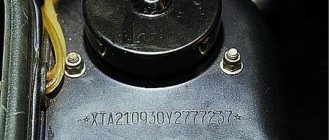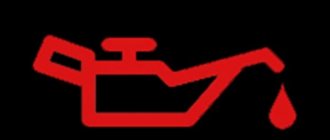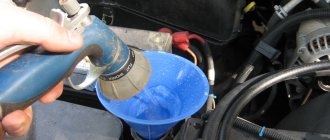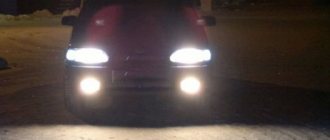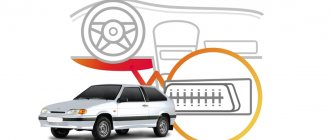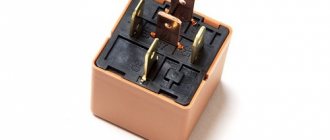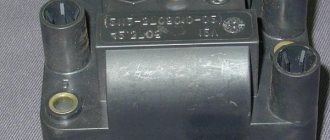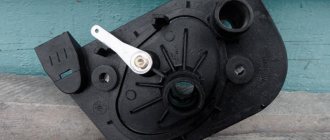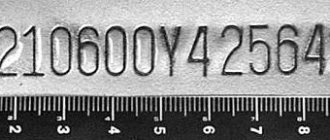Main components of the car
Despite the huge number of models and brands, upon closer examination it turns out that all passenger vehicles are designed the same.
The main parts of any car:
- Engine (motor). The device transforms thermal energy into mechanical energy, which is necessary to transmit torque to the wheels. In other words, it makes the car run;
- Transmission (power train). Responsible for the same torque that is stimulated by the energy source from the motor. This unit includes the following units: gearbox, clutch, cardan transmission, drive axle;
- Chassis (in common parlance – “chassis”). Mechanical basis of car movement. The design includes front and rear suspensions, wheels, drive axles;
- Control systems. Strictly speaking, this is the steering system (to drive) and the braking system (to stop);
- Electrical equipment. This includes the battery, wiring, generator. In a word - sources and consumers of current.
All of the above elements are attached to the supporting structure - the car body. The latter consists of the bottom, front and rear side members (power frame parts that make it strong and stable), engine compartment, roof and attachments (doors, hood, trunk lid, bumper, fenders).
This list is just the tip of the iceberg, but it is quite enough to begin to understand the basic principle of the car.
If you are looking for a textbook or manual that describes the structure of a car in an easy and accessible way, “for dummies,” we recommend that you pay attention to the book by Beskaravayny M.I. “The design of the car is simple and understandable for everyone.” The manual can be easily downloaded online from any online library.
How to properly wash a car under the hood
It is important to remember a few fundamental points that will help keep your engine in working condition after washing.
And the main one is never wash the engine cold or hot. Warm up the engine to operating temperature and wait until it drops to 40 degrees. After this, you can begin applying cleansers.
Be sure to use specialized auto chemicals - it will not only clean the engine, but also protect it from corrosion. Use products whose effects have been proven for decades and which are recommended by car manufacturers: for example, Liqui Moly or Prestone.
First remove a thick layer of dirt with a scraper. At the initial stage, an effective way to remove stubborn dirt is to apply an aerosol or foam. 10 minutes after application, you can remove the soaked dirt with a stream of water.
Use minimal water jet pressure when cleaning attachments. Try not to overdo it - there is no need for excess moisture under the hood. After the engine sparkles with its factory shine, remove the protective polyethylene and go over the remaining dirty units in the engine compartment with a damp cloth.
Now the engine needs to be thoroughly dried. You can use a vacuum cleaner or a dry cloth that absorbs moisture well. Remove all smudges, dry the electrical connectors and additionally treat them with WD-40 lubricant so that any water that may remain on the metal connectors is finally pushed out.
If the hood insulation has been washed, it also needs to be dried thoroughly. The best way to do this quickly is to leave the car with the hood open until it is completely dry. If you have a steam generator, it is better to use it to wash the sound insulation, then drying will take a matter of seconds.
After finishing work, start the engine and let it run for 15 minutes, no more. This way you will completely get rid of any remaining water under the hood and protect yourself from possible problems with interruptions in the operation of the power unit in the future.
But a dirty car hood is not the worst thing that can happen to a car. There are several malfunctions with which your four-wheeled friend will definitely not go far.
Did you like the article? Then support us, click
:
Brief overview of important systems and components of a car device
So, according to the general design of the machine, it works as follows.
Thanks to the body, all components of the device are assembled together. The systems work synchronously and smoothly. The battery is responsible for starting the engine. The latter produces a spark, which ignites the gasoline in the combustion chamber. Detonation starts the movement of the pistons in the engine. The engine, with the help of a transmission (to put it as simply as possible, is the force that turns the wheels) transmits energy to the wheels. The chassis is responsible for the smoothness and correctness of the ride. The car is moving or stopping. These processes are controlled by the gas and brake pedals. In cars with a manual transmission there is also a clutch pedal (more on this below). In order for all the lights and sensors to work, as well as for the on-board computer to function properly, the generator generates current.
The driver, sitting behind the wheel in a comfortable cabin, does not see or feel all the complexity of the technical structure of the car. He just turns the key in the lock, shifts the gearbox lever, presses the pedals, turns the steering wheel, and presses the buttons on the panel. Well, it also controls the fuel level in the tank. A fairy tale, and nothing more!
However, still, if he wants to understand the structure of the car, at least at the “beginner” level, he must understand some more mechanisms.
- An important element of the circuit and structure of a car is the engine (or motor). They are internal combustion (gasoline or gas) and electric. The first ones are divided into a dozen more subspecies, but we won’t go deeper there.
- An equally important part of control is the braking system. It can be parking (to fix the car on an uneven surface) and working (designed to temporarily or completely stop, as well as to reduce the speed);
- Transmission. We are talking about the terms familiar to every driver: “manual” or “automatic”, if correctly - manual transmission and automatic transmission. There is also a robotic box (some mix of the first two), but it is not widely used. An automatic transmission is easier to drive, since it itself controls the speed and load on the car; such a car does not have a clutch pedal. In the case of a manual transmission, the driver, with the help of the latter, independently switches gears, monitoring the load on the car.
What is clutch? How does this element of the device work? Have you ever wondered why, when we start a car, it doesn’t drive right away? Why does it stand still when the engine is running until we change the gear and press the gas pedal (brake and clutch, then gas with manual transmission)? Now let's try to explain:
- The power unit (engine) of a car is equipped with a flywheel and crankshaft. In fact, there is a complex system of gears, shafts and teeth inside, but to delve into the details of this design, you need to have at least a minimum amount of special knowledge. Therefore, we try to explain it more simply.
- A gearbox with a clutch is attached to the engine on the flywheel side.
- The car is started in “neutral” (neutral gear), in which the crankshaft teeth are disengaged. In other words, the box shaft rotates idle, the torque is not yet transmitted to the wheels.
- To start moving, you need to depress the clutch. It will provoke a smooth articulation of the flywheel gears with the transmission. Next, you should turn on the first speed. The entire mechanism will begin to move, you can press the gas pedal. In cars with automatic transmission, this entire process is performed automatically, without driver intervention.
Well, we have analyzed the basic design elements and devices of a modern car, and tried to explain everything as clearly and simply as possible. Now you understand how the car drives, why the engine works, what this or that unit is responsible for.
Few would argue that driving a modern car, especially with an automatic transmission, is a pleasure. But this is only possible if you follow the care recommendations, treat the car with care, undergo maintenance on time and respond to the slightest malfunction.
Clutch
In simple terms, the clutch is designed to briefly separate the engine from the transmission and then reconnect them. The clutch consists of a clutch mechanism and a drive mechanism. The drive is designed to transmit forces from the driver to a specific mechanism. In a car, each mechanism has its own drive, thanks to which it comes into action.
The clutch mechanism is a device in which the process of transmitting torque through friction occurs. The components of the clutch mechanism are the crankcase, casing, drive, driven and pressure plates.
All of the above is just the tip of the iceberg, since each of the points contains dozens more sub-points. For a general understanding of the structure of a car, it is enough to know its main components and assemblies. Now you know exactly how and why your car moves, brakes and consumes gas.
Subscribe to our feeds on Facebook, Vkontakte and Instagram: all the most interesting automotive events in one place.
This article is intended for beginners who need to learn how to understand cars, as well as distinguish between types of bodies.
Many people think that cars are very similar to each other, and the main differences are only the lighting and trunk. But today we will try to master the basics that will help you clarify the situation at least a little.
Each model and brand of car has certain features. However, they also have a lot in common. If you intend to have a good understanding of vehicles and distinguish between existing types of car bodies, then let's get started!
Electrical and driver assistance systems
Much of the car is controlled electrically. It is quite complex, but it greatly facilitates the driving process and makes your stay in the cabin as comfortable as possible. It is she who starts the engine, keeping it in working condition. The control unit, battery, generator, distributor, spark plugs - all these are separate parts of the car, without which it is impossible to imagine its normal functioning.
Secondary elements of auto electrics are lighting sources: headlights, side lights, turn signals, interior lighting, etc. This also includes a sound signal, all kinds of sensors and regulators.
Electrical equipment can also include systems designed to improve the vehicle's directional stability and controllability.
Brake system
Allows you to slow down the movement of the car, until it comes to a complete stop. The system is indispensable during emergency situations, as well as when the car needs to be kept from spontaneously moving down. Car brakes include several subsystems: manual, spare, auxiliary, and anti-lock. Their combination is called braking control.
The task of the main braking system is to regulate the speed of the car and stop the vehicle if necessary. It consists of a drive and actuators (drum, disk). On modern passenger cars, a hydraulic drive is more often used, less often - electric, pneumatic or combined options. In some cases, a vacuum booster and regulator are used to increase fluid pressure and braking efficiency.
If the main brake fails or malfunctions (depressurization of one of the circuits and the fluid level drops to critical), the backup brake system is activated. It works as a stand-alone unit or in conjunction with a handbrake.
A manual or parking brake equipped with a mechanical drive is intended for:
- holding the car on descents;
- emergency braking in emergency situations.
Deceleration efficiency coefficients for a vehicle moving at a speed of 80 km/h with a pedal force of up to 50 kg of the main system and subsystems:
- main brake - not less than 5.8 m/s2;
- emergency and manual - 2.75 m/s2.
The principle of operation of brakes is simple. After pressing the pedal, the braking force is transmitted to the wheel mechanisms. The latter press the pads against the discs, thereby stopping rotation.
What's next?
Gas 4-stroke internal combustion engine of Nikolai-August Otto and Eugene Langen (1876)
Marketing of the global auto industry is quite simple. Every 3-5 years, the consumer must change the car, and, of course, for a more modern, improved one - more economical, environmentally friendly, powerful and easy to operate. From an environmental point of view, the surest way is to switch us all to electric cars. Indeed, an electric car produces almost no emissions of harmful substances. In addition, the electric motor has high torque at low speeds. An electric car requires fewer adjustments, is not critical to lubrication, has a simpler cooling system, and does not have a fuel system at all. The main drawback that holds back the adoption of electric vehicles is the low energy consumption of batteries. The tank of a small car, filled to capacity, weighs about 50 kg, providing a power reserve of more than half a thousand kilometers. Batteries usually weigh several hundred kg, and the range on fully charged batteries does not exceed 100–150 km, and when driving at low speed. But that's not even the biggest problem. If all cars today were replaced by electric vehicles, they simply would not have enough electricity. The fact is that the total power of the engines of the world vehicle fleet is several tens of times greater than the total power of all power plants in the world.
As you know, not so long ago, designers of a number of leading companies proposed a palliative - to place an individual power plant on board the car: piston internal combustion engine - generator - battery - electric motor. In city driving mode, the main load is carried by the electric motor, on the highway - by the internal combustion engine, which simultaneously charges the batteries. The operating algorithm of the entire system is designed so that the internal combustion engine constantly operates in the most optimal mode, both from an economical and environmental point of view. Hybrid vehicles are becoming increasingly accepted, especially where environmental regulations are most stringent.
The structure of a modern car
The automotive industry does not stand still, and is constantly being improved, in connection with this, there is a constant change in the components of vehicles, however, the basic components and assemblies remain unchanged:
- Internal combustion engine;
- Transmission;
- Body;
- Salon with various functions and options.
Engines are divided into several types, this division is made according to the type of fuel used during operation. Engines are diesel, gasoline, gas and combined. The composition of all engines is almost the same, it consists of the following components:
- Cylinder block.
- The cylinder head, which includes the camshaft and valves.
- The crank mechanism, which includes a crankshaft, piston and connecting rod.
- Cooling system, including a water pump, radiator, fan, temperature sensor, expansion tank, thermostat and system pipes.
- Lubrication system consisting of an oil pump, oil intake, filter element and emergency pressure sensor, oil level sensor.
- The power supply system is partly related to the engine and consists of a fuel pump, fuel injectors or carburetor, and throttle assembly.
- Electronic control includes an engine control unit and a diverse set of sensors responsible for the operation of the internal combustion engine.
The working principle is to convert thermal energy into mechanical energy. The air-fuel mixture enters the combustion chamber through the intake valve, through the vacuum created by the piston into the cylinder. Then the mixture is compressed due to the upward movement of the piston when the valves are closed.
At the moment of critical compression, a spark is supplied, which ignites the mixture and forces the piston to move downwards, then the exhaust valve opens and the exhaust gases enter the exhaust manifold. The operation of a diesel engine is slightly different, where ignition occurs under strong compression without a spark.
Hybrid engines and electric motors have also become increasingly common in recent years. The hybrid version uses an internal combustion engine to rotate the generator, and the wheels are driven by an electric motor. The main difference is the presence of rechargeable batteries. Electric cars are driven by an electric motor and energy comes from batteries.
The transmission also has several design options depending on the drive of the vehicle.
The transmission of a front-wheel drive car includes a gearbox and drive with constant velocity joints.
The gearbox also has options such as:
- Automatic;
- Variable speed drive;
- Mechanical;
- Robot.
The transmission of a rear-wheel drive vehicle additionally includes a cardan transmission and a rear axle or gearbox. In the bridge, the implementation of torque transmission is organized by axle shafts, and in gear versions, also by constant velocity joints.
The transmission of an all-wheel drive vehicle also has options:
- Gearbox, cardan drives, transfer gearbox and front and rear axles of the car.
- Gearbox, cardan drives, angular gearbox, rear axle gearbox, and constant velocity joints.
It should be noted that there are also mixed options for implementing all-wheel drive.
The transmission ensures the transmission of torque from the internal combustion engine to the wheels of the vehicle.
Has many variations:
- Sedan;
- Coupe;
- Station wagon;
- Hatchback;
- Liftback;
- Cabriolet;
And many more different variations without taking into account commercial vehicles. The car body plays one of the most important roles in the safety of the driver and passengers, and an important component of the body is its aerodynamic properties, which reduces fuel consumption and increases speed performance. The body includes such parts as: doors, trunk lid, hood, bumpers, glass, seals, body base with side panels, fenders and roof.
The interior of a modern car has a high level of comfort due to many vehicle systems. The air conditioning device ensures the creation of a comfortable microclimate inside the car, regardless of the weather outside. Some vehicle models are equipped with multi-zone climate control, which organizes the microclimate for each individual passenger.
Car seats now have many adjustments, so any driver or passenger can adjust the seats for a comfortable fit. The seats also have heating, cooling and even massage functions. Many cars are currently equipped with light and rain sensors, which undoubtedly creates driver comfort.
And don’t forget about the auxiliary systems: parking radar, surveillance cameras around the perimeter of the car, parking assistant. Multimedia devices allow you not only to listen to audio files, but also to watch videos and have Internet access; many systems have Bluetooth installed, which allows you to communicate by phone using multimedia without being distracted from driving the vehicle.
Modern cars are completely enveloped in electronics, from the engine control unit to the tire pressure sensors. The engine and other functions are controlled by software using the ECU (electronic control unit).
The braking system is controlled using sensors and the ABS control unit. The traction control function is also controlled electronically. On a modern car, almost 90% of the elements are connected to electronics.
The rear suspension of the car is divided into dependent and independent suspension. The dependent suspension is implemented with a beam, shock absorbers, and springs. There are options for springs instead of springs or air springs. An independent suspension consists of a semi-frame with levers; this suspension is softer and more comfortable, unlike a dependent suspension.
The front suspension also has control arms, knuckles, stabilizer bars, shock absorbers and springs or options. On SUVs you can find torsion bar suspension. The difference between this suspension is the use of a torsion bar instead of springs.
The steering consists of a rack and pinion mechanism connected to the steering wheel via steering cardan gears and power steering (hydraulic or electric). The hydraulic booster operates using hydraulic oil pumped into the steering rack; the electric booster is organized by an electric motor mounted directly on the steering mechanism.
These systems are distinguished by the principle of operation: hydraulic and air brake systems. The air system is in most cases implemented on cargo vehicles and operates due to air pressure pumped into cylinders by a compressor.
The hydraulic brake system consists of a master cylinder with a vacuum booster, brake wheel cylinders, brake discs or drums, brake pads, and a parking brake system. The operation of this system is to transfer a portion of brake fluid to the working brake cylinders, resulting in an impact on the brake pads, which stop the disc and, accordingly, the vehicle.
These are just the basic systems of a car, and we should not forget that any type of transport is a technically complex structure, consisting of many systems that interact with each other.
How to change the engine on a VAZ 2114
The VAZ 2114 engine changed throughout the entire production period of this car. The first models of the VAZ 2114 or “Samara-2” (as it began to be called by analogy with its predecessor) rolled off the production line with an engine from the VAZ 2109. It was an eight-valve injection engine with a relatively small volume - only one and a half liters. This engine did not differ in terms of developed power, which was 78 horsepower.
Tuned VAZ 2114 engine
Since 2007, VAZ 21114 engines began to be installed on cars, with an increased volume of 1.596 liters and a maximum power of 80-84 hp. With. This engine complied with the Euro-3 environmental standard.
And since 2010, a model with a 16-valve engine has been produced. It's also a four-cylinder engine, but instead of two valves per cylinder there are four. The 16-valve engine has more power - 98 horsepower, faster acceleration, but is more susceptible to breakdowns than the eight-valve engine.
Thus, under the hood of the VAZ 2114 there are key mechanisms, the main one of which is the engine. Its operation is based on a distributed fuel injection system, which is regulated by an electronic control unit.
Purpose and requirements
If the engine is called the heart of the car, then the body is its shell or body. Be that as it may, the body is the most expensive element of the car. Its main purpose is to protect passengers and internal components from environmental influences, to accommodate seats and other elements.
Car body
As an important structural element, the body is subject to certain requirements, including:
- corrosion resistance and durability;
- relatively small weight;
- required rigidity;
- optimal shape to ensure repair and maintenance of all vehicle components, ease of loading luggage;
- ensuring the necessary level of comfort for passengers and the driver;
- ensuring a certain level of passive safety in a collision;
- compliance with modern standards and design trends.
Why is it needed and how does it work?
It's no secret that the hood of a car protects its engine and other parts of the engine compartment from the negative influence of external factors. This detail is also very important for the aerodynamics of the car. It also isolates engine noise and vibration from the driver, passengers and other road users.
Considering the importance of the functions that the hood performs, it is not at all surprising that it should be extremely reliable, namely, resistant to high and low temperatures. The fact is that the operating temperature of the motor is very high and can involuntarily lead to failure of this part. This is why most car manufacturers make hoods from high-quality steel.
Main types
Before you understand what a car body is made of, you need to identify the main types of its design. Mass-produced passenger cars are produced in the following main types:
- sedan;
- hatchback;
- station wagon
There are other types, but these three are the main and most common.
The sedan body type is the most popular. The serial sedan has four doors for passengers, an engine compartment and a luggage compartment. This type of body is the most optimal for transporting passengers and small luggage.
A hatchback is a car with two doors for passengers, an engine compartment and a luggage compartment not shared with the passenger compartment. This type has limitations on the cargo it can carry, and is also not very convenient for transporting passengers. However, this implementation has its advantages. Cars in this type of body have a lower weight and size, which has a positive effect on its efficiency in relation to fuel consumption.
Station wagon passenger cars are designed for heavy loads. The luggage compartment of such cars is characterized by an increased volume, which does not prevent the interior from remaining at its full size. The station wagon design makes it possible to further expand the luggage compartment by folding the rear passenger seats.
What does a car consist of?
Of course, the structure of a modern machine includes many different components and parts, but even among them the main ones can be identified:
Each of these elements plays an important role that is difficult to overestimate. To understand how important the correct operation of each part is, let’s look at them in more detail.
Body
The body is the supporting part of the car. It is to it that all components and assemblies are attached. Nowadays, automobile manufacturers are trying to do everything possible to select the most durable and lightest composite resin that will serve as the basis of the product.
The fact is, ordinary metal weighs quite a lot. Increasing weight negatively affects dynamics, top speed and acceleration, and driving a heavy car is very difficult. As a result, non-standard approaches to creating bodies are now increasingly being used. For example, hydrocarbon fiber is used in construction.
Material and manufacturing technology
The body of a modern passenger car is made of high-strength steel, which goes through several stages of processing. The small thickness of the metal used makes it possible to significantly reduce the overall weight of the machine, which has a positive effect on its dynamics and efficiency. Despite the small thickness of the steel, the body structure is designed in such a way that it is both light and strong.
On most modern cars, body parts are joined together by spot welding. This makes it possible to ensure reliable connections between elements and reduce the number of edges and sharp corners that are most vulnerable to corrosion. In the future, the automotive industry will use laser welding of parts. This approach minimizes the presence of bulges and depressions at the seams, and the body structure will become simpler and more reliable.
Post Views: 4,478
What does replacing a car’s “business card” mean?
Correctly installing the hood yourself is not as easy as it seems at first glance. Firstly, this is due to the fact that today there is a huge amount of used and new hoods of various modifications on the automotive spare parts market. Outwardly, they are all similar to each other, and a person who does not understand will not be able to purchase the part that is really needed.
Secondly, nowadays most car enthusiasts trust their iron friend to professionals. Technology improves, time passes, and fewer and fewer people prefer to repair their car themselves. In addition, due to its importance, it is better to entrust the hood to a professional who is endowed with all the necessary knowledge and equipment to repair or replace it.
Replacing a hood in a car repair shop usually consists of three stages:
If you have used the services of a specialist, then it would be a good idea to ask him for a long-term guarantee on the installed part.
